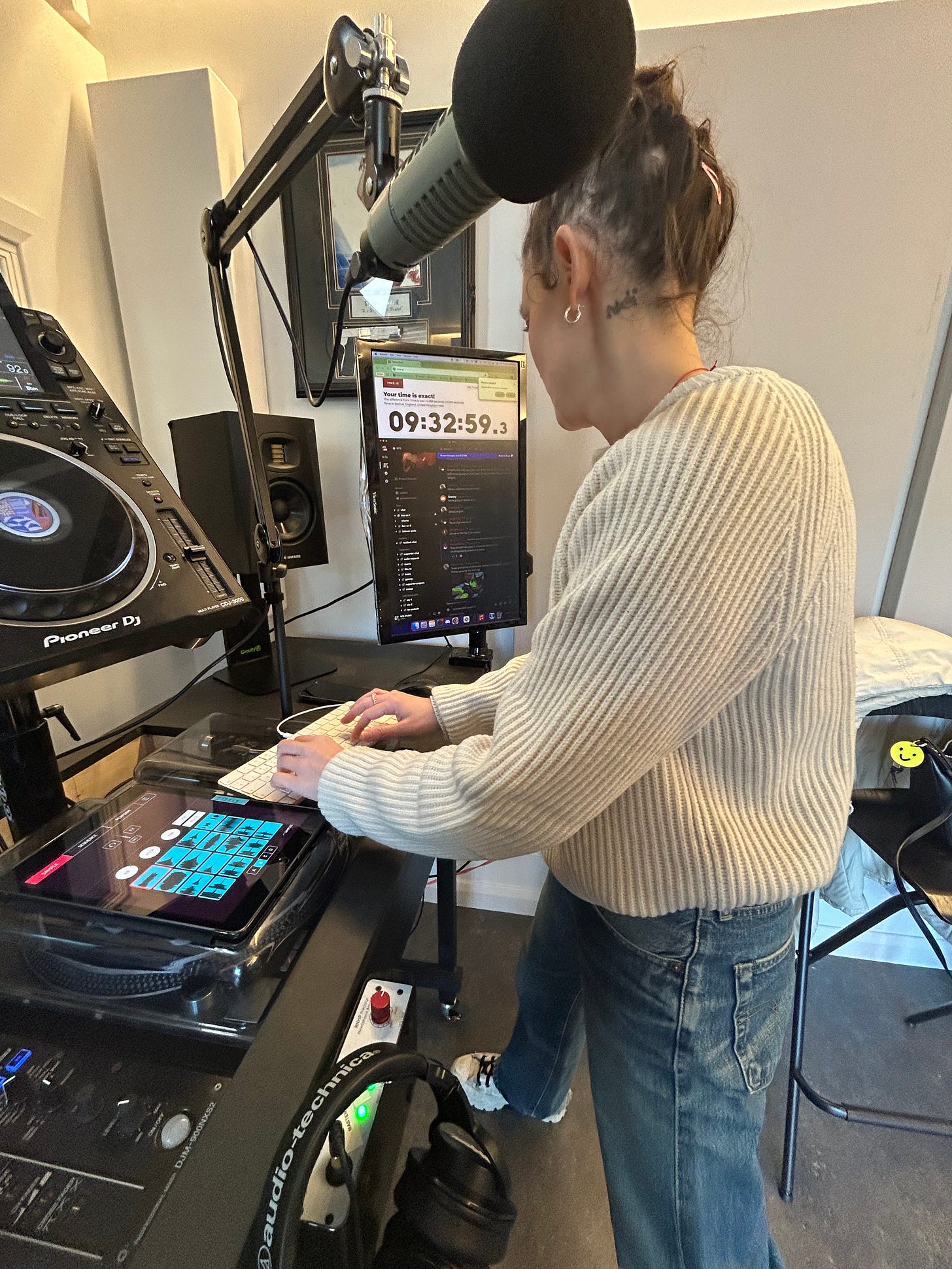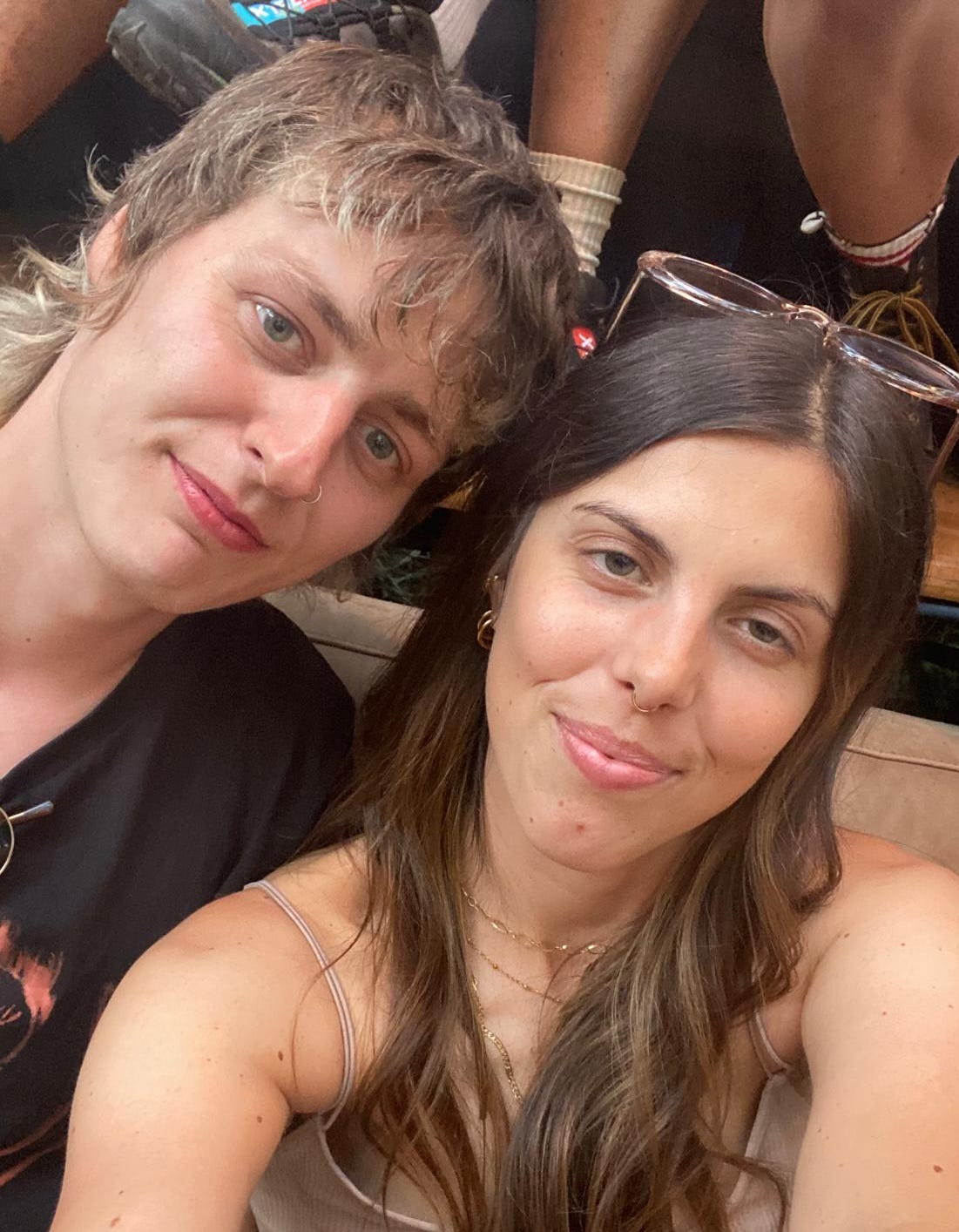Radio has entered the chat
Inside the internet’s most wholesome chat room, the NTS Discord chat
On a fresh Friday morning, I join DJ and radio show host Louise Chen in the NTS Radio studio for her flagship Breakfast Show. She expertly dips between the music, microphone, and online Discord chat room, which is blown up on a vertically flipped computer monitor to the right of her decks. New messages pour in as chat room regulars welcome each other with morning greetings.
Between head bobs and track blends, Chen confirms that the 92-BPM R&B and hip-hop vibe was a good choice for the day — first to me in the booth and then into the microphone for the listeners, her voice going hushed and gooey. She pops over to the Discord chat to check replies, typing out messages about Oscars wins, Big Tobacco conspiracies, and even the accident that took the life of her late partner, all between soul-affirming D'Angelo and Toni Braxton tracks. Bouncing to the output of her craft and doting generously on the Discord chat, she’s at ease, an effortless multitasker.
“Everyone has their own lives,” she says of the chat room, “and the more time you spend there, the more you start caring about everyone's life because, in the end, that's what it is — a place to make friends and music. It’s like the radio is just an excuse.”
NTS Radio launched as an independent online radio station in 2011, the brainchild of music blogger, DJ, and pirate radio enthusiast Femi Adeyemi. Housed in a former jazz record shop in Dalston, the station has amassed a mammoth following of 360,000 daily listeners — an audience base of algorithm cynics, subculture enthusiasts, and all-around alternative music nerds.
The station strives to act as a music discovery platform, opposing the automated lull of algorithmic streaming platforms (with approximately 40% of its music unavailable on Spotify) and broadcasting a grand scope of genres from techno, dub, and jazz to the more obscure-leaning krautrock, new jack swing, and musique concrète.
In 2022, NTS made the switch from the clunky chat system Chatango to Discord, the instant messaging social platform originally used for mobile gamers. Three years later, the chat room is brimming with activity, home to over 61,000 users.
Through the chat room, NTS has moulded an oddly friendly corner of the internet where young, liberal, and often neurodiverse individuals discuss the intricacies of music, trade matters-of-the-heart tales, and plunge into deep, topical rabbit holes with one another. Here, people are connecting — both digitally and IRL. They are meeting for beers in local pubs, collaborating on creative projects with one another, and for some, even finding love.
Elena Ferrari and Paul van der Donk danced around each other in the chat for a while before they met up, connecting first through their mutual love of music between the 9 am NTS Breakfast Show and the 11 am Soup to Nuts show.
In September of last year, 28-year-old van der Donk sent 32-year-old Ferrari a private message after she asked about good parties happening in Amsterdam that weekend. While the two didn’t meet then, their private messaging continued. Two months later, when they were each going through separate breakups, they started a joint heartbreak playlist, laden with angsty, dramatic, and unapologetically emotional songs.
“During this time we messaged every day. Hours per day,” said van der Donk. “We were kind of dragging each other through.”
By November, they made a plan to hang out in real life, meeting at a cosy Dutch bar with craft beers and good music. 10 or 11 drinks in, they shared their first kiss. They’ve been dating ever since.
Like a new couple, they’re still settling into the grooves of one another. In the chat room, they’ve kept their relationship mostly secret, even though, according to von der Donk, “We talk to these people every day. We involve them in every part of our lives, but none of them know that we have a relationship. I think it's weird, but Elena finds it amusing.”
Sian O’Neill, on the other hand, has less of a filter when dishing the particulars of her love life. The lingerie designer and side-hustle DJ is a capacious presence in the chat, recounting dating tales with humorously intimate levels of detail, down to photos of her crushes, which she “dirty deletes” after a couple of minutes.
“My personal friends can be biased or tell me what I want to hear. But I know that these neurodiverse people and weirdos in this Discord will always give me the most honest feedback advice ever,” she says.
The Germany-based 33-year-old started listening to NTS Radio five years ago and joined the chat two years later. She tells me that she can tell the mood of the DJ based on the opening track of their show or even by the tone of their voice, having once joined together with other listeners to send flowers to radio host Flo Dill at the studio because “we thought that she wasn't feeling so great.”
The DJ-listener barrier crumbles beneath the weight of instantaneous chat room communication. Ferrari speaks fondly of the messages she would receive from Flo Dill when she was low on heartbreak. The DJ would send well wishes and check in on her to make sure she was okay.
“It felt really like a support group that I could find there,” she says.
According to radio specialist Grant Goddard, it takes two traits to make a good DJ: an intensely deep knowledge of music and an inherent talent for conversation.
With over 50 years of experience in music and talk radio, both in the UK and globally, Goddard has seen the industry cycle through its many evolutionary shifts.
“We haven't seen the death of broadcast radio, but we have seen the rise of online radio because generally, it's doing different things,” says Goddard.
Online radio is steadily gaining popularity, having surpassed AM/FM radio listening in the UK for the first time last year. The two mediums still grapple for listenership — a recent Q4’24 RAJAR report found that in the UK, 27% of adults listen to AM/FM radio while another 27% listen to online radio; however, that’s not accounting for independent radio stations like NTS that don’t fall under the RAJAR’s scope of survey.
NTS, with its three million monthly listeners, emulates a return to basics with its tastemaker DJs and live shoutouts. “It's bringing back some of the elements of traditional radio that made it so successful,” says Goddard.
Will Dickson, 32, is the head of marketing and communications at NTS and the Discord chat room administrator. As someone who’s been with NTS for close to 10 years, he conducted the switch from Chatango to Discord and recognises the pivotal connecting power of a chat room. With about 1,000 new Discord members joining each month, NTS’ chat room is on a steady upward climb, with most activity occurring during the Breakfast Shows.
“If we didn't have the chat, it's like almost, what's the point of broadcasting live?” Dickson says. “It really helps to add to that sense that you're experiencing content together with people in exactly the same way, and at the same time. It makes the broadcast an event. It's crucial.”
There’s a game of push and pull occurring between technology and the elementary human experience. A growing trend is taking shape as people shift away from social media, dating apps, and the algorithms that dictate what we listen to and watch. Instead, people are returning to old-school forms of human interactions like board game cafes and speed dating. While the Discord app is tech-forward, it’s also reminiscent of the chat rooms of the 90s and 2000s, like AOL, Yahoo, and MSN Messenger. Online radio stations like NTS scratch an analogue itch, where listeners can surrender control of the aux cord and be led by the experience a DJ creates.
“People are sick of algorithms. They want curation back,” Isaac Carter tells me. The 24-year-old spent the past five years working in commercial radio in New Zealand before changing course and returning to school to become a secondary school teacher. After seeing the industry from the inside, he lost faith in radio as a medium.
Carter is not the type to gravitate toward an online chat room, and it took him a while to participate, but once he did, he grew fond of the chat’s community feel, tuning in to The Breakfast Show as his nighttime wind-down.
“It's not infiltrated by weirdos, which is a very rare thing for an internet space,” he says. “It's almost bizarre. It feels otherworldly for the internet.”
Pondering over his draw to the chat room, he says, “Maybe it's just cause of everything going on in the world right now. It seems a bit closed off from it in a good way.”
“People turn to something for reassurance to try and combat the feeling of isolation,” says Goddard. “When there's war going on, whether that be a literal war or a trade war as we've got now, people tend to move towards that because it's a frightening time for people and they need more empathy than they would normally.”
The pandemic, although terrifying, brought listeners together in a new way, when, according to Chen, “live radio took on a new meaning in people's lives because of that moment of communion and shared experience.”
She adds, “I was living alone at the time. It felt like the NTS chat room and the shows were one of the rare moments where I had social interactions, even if they were digital. The fact that they were live felt like the closest thing to hanging out with real people.”
Five years later and the world spins on, new global conflicts arising, bristling, and causing safe spaces like the NTS Discord chat to feel especially remarkable. On any given morning in the NTS chat room, you’ll likely be greeted by familiar usernames from quick-typing regulars.
“good morning pals”
“Ahoy sailors”
“how the fuck are we”
“Morning all. What’s this then?”
These not-so-strangers might be in the same city as you — down the block or up the road. More likely, they’re further away, perhaps by nautical leagues, on the other side of one ocean or another.
Still, whether you’ll ever meet or not, for some time you’re all sharing a moment of wholesome togetherness, hearing the same breathy DJ’s inner monologue, shimmying to the same Swedish indie-pop tune, and smirking at the same devil-may-care messages and GIFS flooding the chat at breakneck speeds. In these moments, the room in chat room takes on a more solid emphasis, the music and messaging painting walls of sound and colour around you. In these moments, it’s hard to feel alone.
A condensed version of this piece was published in the summer 2025 print edition of Artefact Magazine.





From the States side of the ocean, I have made many new friends during and after the pandemic and quite frankly, it's preserved my sanity! It also gives a chronic insomniac something healthy and fun to do.
Met a core group of friends through that chatroom. Forever grateful <3